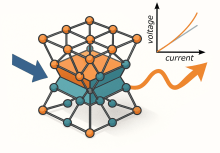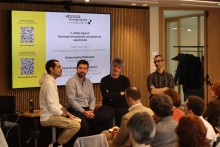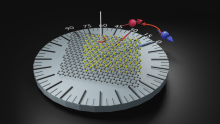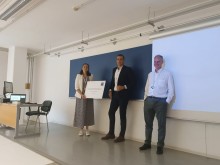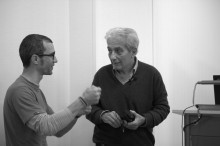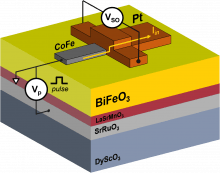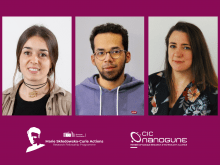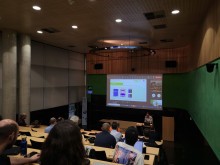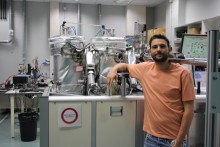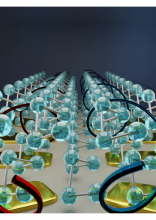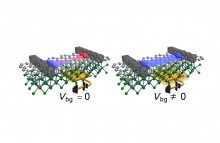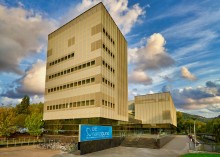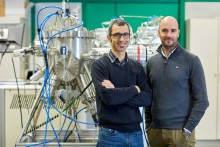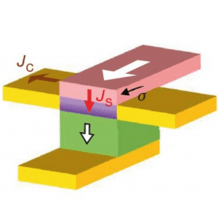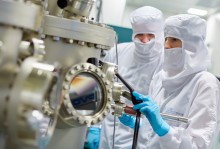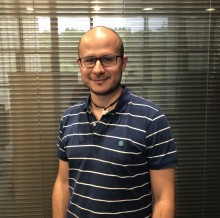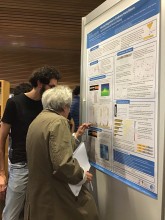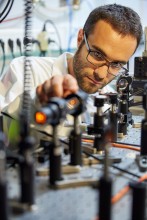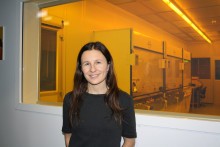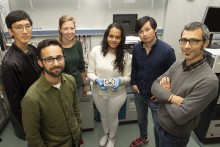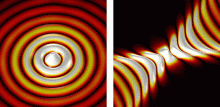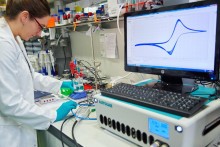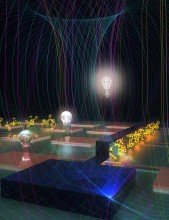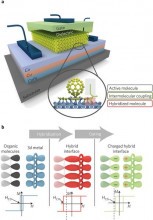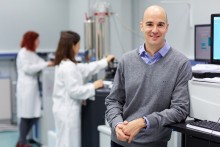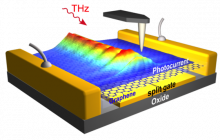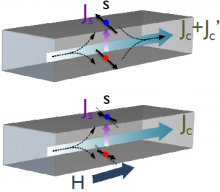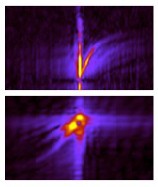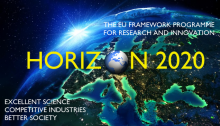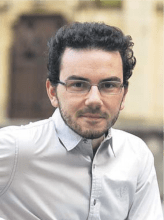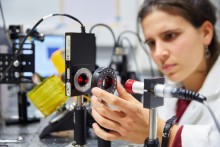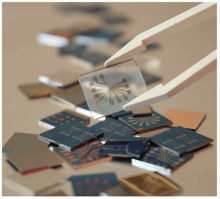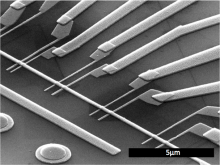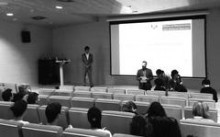Nanodevices News
Últimas noticias
Beatriz Martín García receives one of the 2025 Journal of Materials Chemistry Lectureship runner-up awards
Breaking Ohm’s Law: Nonlinear Currents Emerge in Symmetry-Broken Materials
Donostia, capital de la espintrónica y la orbitrónica
Encuentro sobre el futuro digital de Euskadi
Revelan propiedades de espín inéditas en nuevos materiales artificiales
María Barra recibe el premio Nanolito por su Tesis Doctoral
Transformando la tecnología digital a través del proyecto SPEAR ITN
El proyecto SPEAR ITN (Spin-orbit Materials, Emergent Phenomena and Related Technologies Training), coordinado por el CIC nanoGUNE, es una red europea multidisciplinar que forma a una nueva generación de investigadores e investigadoras altamente cualificados capaces de abordar las futuras tecnologías de memoria y...
Electrical control of magnetism by electric field and current-induced torques
In a recent review article published in Reviews of Modern Physics, Fèlix Casanova from the Nanodevices group at CIC nanoGUNE, Prof. Albert Fert, Nobel Prize in Physics, and his colleagues review the state of the art of electrical control of magnetism and give scientific and technological future persperctives.
The building block for magnetoelectric spin-orbit logic
In a recent article published in Nature Communications an international team, led by researchers from the Nanodevices group at CIC nanoGUNE, suceeded in voltage-based magnetization switching and reading of magnetoelectric spin-orbit nanodevices. This study constitutes aproof of principle of these nanodevices, which...
CIC nanoGUNE obtains three Marie-Sklodowska-Curie Individual Fellowship projects
The Cooperative Research Center nanoGUNE has achieved three Marie-Sklodowska Curie Individual Fellowship projects in the 2023 call, obtaining 624.071,52€ in total. The objective of this European programme is to support the education and the professional development of postdoctoral researchers by offering them a...
Nanodevices group hosts Interfast and Sinfonia project meetings
Fèlix Casanova recibe, por segunda vez, el Premio Intel al Investigador Destacado
El investigador Ikerbasque Fèlix Casanova, colíder del grupo de Nanodispositivos de nanoGUNE, ha sido galardonado con el Premio Intel al Investigador Destacado 2022, por sus contribuciones en la tecnología MESO, una tecnología que ha tenido en cuenta desde su concepción los requerimientos de memoria,...
CIC nanoGUNE joins the Basque Microelectronics Hub – BMH
Francesco Calavalle, winner of the GEFES award for best experimental thesis
The researcher Francesco Calavalle has been awarded the prize for best experimental PhD thesis by the Condensed Matter Physics Division (GEFES) of the Spanish Royal Physics Society (RSEF). The thesis “Probing and tuning the properties of van der Waals materials“ was worked on at CIC nanoGUNE, under the supervision...
Abierto el plazo de inscripción del programa de prácticas de verano
Magnet-free chiral nanowires for spintronic devices
Researchers from the Basque Nanoscience Research Center CIC nanoGUNE (San Sebastian, Spain), in collaboration with POLYMAT (San Sebastian, Spain), the Institute of Physics of the Martin Luther University Halle-Wittenberg and the Max Planck Institute of Microstructure Physics (both in Halle, Germany) demonstrate the...
Spin Control Without Magnetic Fields
Researchers from the Nanodevices Group at CIC nanoGUNE demonstrate that they can control the polarization direction of a spin current without having to apply a magnetic field, which could aid in implementing energy-efficient spintronics devices. The work has been published in Physical Review Letters.
Fèlix Casanova recibe el Premio Intel al Investigador Destacado 2020
El investigador Ikerbasque Fèlix Casanova, el líder del grupo de Nanodispositivos de nanoGUNE, ha sido recientemente galardonado con el Premio Intel al Investigador Destacado 2020, por sus contribuciones en la tecnología MESO, una tecnología que mira a las necesidades de los dispositivos electrónicos del futuro.
CIC nanoGUNE recibe 1,5 millones de euros de la Comisión Europea
Tres proyectos de investigación de CIC nanoGUNE han sido seleccionados en la convocatoria europea FET Open (Future and Emerging Technologies). Las iniciativas FET Open tienen por objetivo fortalecer grandes proyectos de investigación científica y técnica de alto riesgo realizados en colaboración. Son proyectos...
Un proyecto coordinado por CIC nanoGUNE recibe cerca de 4 millones de euros de la Comisión Europea
CIC nanoGUNE coordina el proyecto SPEAR que persigue estudiar nuevos materiales para la próxima generación de memorias y procesadores para computación, junto a cinco instituciones académicas (CEA-Francia, ETH Zuric-Suiza, IMEC-Belgica, U. Hamburg - Alemania, Martin Luther University Halle –Alemania) y tres empresas...
Low-power spin detection in non-magnetic systems
A team of researchers from Université Grenoble Alpes - CNRS - Spintec, Unité Mixte de Physique CNRS-Thales, and Université d'Evry, and also including Dr. Diogo. C Vaz, currently at CIC nanoGUNE, reports on an alternative strategy to achieve low-power spin detection in a non-magnetic system. The results have now...
CIC nanoGUNE e INTEL acercan la tecnología MESO un paso más cerca de la realidad
El centro vasco de investigación en nanociencia CIC nanoGUNE y la multinacional Intel, el mayor fabricante de circuitos integrados del mundo, trabajan duro en el último año y medio en una tecnología con la que miran a los dispositivos electrónicos del futuro: la tecnología MESO. Esta tecnología integra la lógica y...
PhD thesis by Juan Manuel Gomez: Spin-transport in magnetic insulator/heavy metal heterostructures
Juan Manuel Gomez, Pre-doctoral Researcher at the Nanodevices group at nanoGUNE, received his PhD at the University of the Basque Country (UPV/EHU) after the defense of his thesis project at the beginning of 2020. His research work, entitled “Spin-transport in magnetic insulator/heavy metal heterostructures" ...
nanoGUNE PhD Workshop 2020
nanoGUNE lanza una nueva convocatoria de prácticas de verano para universitarios
Edurne Sagasta, Premio GEFES 2019 mejor tesis experimental
La investigadora Edurne Sagasta ha sido galardonada por la División de Física de la Materia Condensada (GEFES) de la Real Sociedad Española de Física (RSEF) con el premio a la mejor tesis doctoral experimental. La tesis titulada Spin-to-charge current conversion in systems with spin-orbit coupling fue realizada en...
CIC nanoGUNE colabora con Intel para abrir camino a los futuros ordenadores
El centro vasco de investigación en nanociencia CIC nanoGUNE y la multinacional Intel, el mayor fabricante de circuitos integrados del mundo, trabajan conjuntamente en un proyecto puntero que persigue desarrollar lo que Intel ha denominado el dispositivo “MESO”, una nueva tecnología que ha tenido en cuenta desde su...
Apply for a Basque PhD grant with nanoGUNE
NanoGUNE, located at the Ibaeta Campus of the UPV/EHU in Donostia – San Sebastián, offers PhD opportunities to graduates in Physics, Chemistry, Engineering, Biology, and related areas to get their PhD degree.
Investigadores vascos ponen la luz “patas arriba”
CIC nanoGUNE participa en dos proyectos europeos para formar a jóvenes investigadores
NanoGUNE participará en dos nuevos proyectos sobre la electrónica cuántica y los recubrimientos híbridos en uno de los programas más competitivos de Europa, las Redes de Formación de la Unión Europea, Initial Training Networks (ITN, de sus siglas en inglés) a partir de enero de 2018. Gracias a esta participación,...
Los electrodos magnéticos aumentan la eficiencia de las células solares
Molecular spintronics in Nature Materials
Materials for second-generation information and communication technology applications should be as small and as fast as possible. It is precisely these kind of materials that Ikerbasque Prof. Luis Hueso, head of the Nanodevices Group at nanoGUNE is seeking for, together with his colleagues Mirko Cinchetti (TU...
ERC Proof of Concept para Luis Hueso
El grupo de Nanodispositivos del CIC nanoGUNE recibe una dotación de 150.000 euros de la Comisión Europea a través del programa ERC Proof of Concept, cuyo objetivo es poner en práctica el potencial innovador de las ideas generadas en proyectos de investigación de vanguardia financiados por el Consejo Europeo de...
Programa de Prácticas de Verano: Convocatoria abierta hasta el 5 de febrero
Detección eléctrica de plasmones de grafeno a frecuencias de terahercios
Un grupo de investigadores ha desarrollado una nueva técnica para visualizar fotocorrientes en la nanoescala, y la ha aplicado para observar ondas electromagnéticas extremadamente comprimidas (plasmones) a frecuencias de terahercios en un fotodetector de grafeno. Tanto la longitud de onda extremadamente corta de...
Coexistence of superconductivity and charge density waves observed
Scientists at Max Planck Institute for Solid State Research, BESSY II Synchrotron and nanoGUNE have discovered that an artificial structure composed of alternating layers of ferromagnetic and superconducting materials induce Charge Density Waves deeply into the superconducting regions, indicating new ways to...
Spin injection in two-dimensional layered materials, PhD thesis by Oihana Txoperena
Oihana Txoperena, Pre-doctoral Researcher at the Nanodevices Group at CIC nanoGUNE, received her PhD at the University of the Basque Country (UPV/EHU) after the defense of her thesis project on 8th April 2016. Her research work, entitled “Spin injection in two-dimensional layered materials", has been developed...
A new magnetoresistance effect occurring in materials with strong spin-orbit coupling
Researchers of the Nanodevices group, in collaboration with groups from the CFM and DIPC, both institutions also located in Donostia-San Sebastián, have discovered a new magnetoresistance effect occurring in materials with strong spin-orbit coupling. This new effect has been recently reported in the prestigious...
Frenando la luz en la nanoescala
La velocidad de la luz cuando viaja en el vacío es siempre la misma, algo inferior a 300 millones de metros por segundo. Sin embargo, cuando cambia de ambiente su velocidad puede variar. En el CIC nanoGUNE han estudiado cómo se propaga la luz en un tipo de materiales muy especiales conocidos como materiales...
El grupo de Nanodispositivos participa en el proyecto Fet Open 2D-INK de la UE
El proyecto 2D-INK, coordinado por el grupo de Materiales Moleculares y Supramoleculares de POLYMAT-UPV/EHU, ha sido financiado por la Unión Europea con 2.962.661 €. El proyecto busca desarrollar tintas constituidas a partir de materiales derivados del grafeno con propiedades semiconductoras, que son las...
Charge and spin transport in graphene devices, PhD Thesis by Luca Pietrobon
Luca Pietrobon, Pre-doctoral Researcher at the Nanodevices Group at nanoGUNE, receives his PhD at the University of the Basque Country (UPV/EHU) after the defense of his thesis project on Friday 5 June 2015. His research work, entitled “Charge and spin transport in graphene devices", has been developed under...
Becas nanoGUNE: abierta la convocatoria para los estudiantes de máster
La investigadora del CIC nanoGUNE Estitxu Villamor ha obtenido una mención especial en los Premios CAF-Elhuyar
La investigadora Estitxu Villamor, que ha realizado su tesis doctoral en el grupo de Nanodispositivos de nanoGUNE, ha recibido el diploma de mención especial en los Premios CAF-Elhuyar. El objeto de estos premios es fomentar, premiar y reconocer la divulgación, el periodismo y la socialización de temas e...
“Nanostructuring of Devices for Nanoscience Applications”, PhD Thesis by Libe Arzubiaga
Libe Arzubiaga, Pre-doctoral Researcher at the Nanodevices Group at nanoGUNE, receives her PhD at the University of the Basque Country (UPV/EHU) after the defense of her thesis project on Monday 16 March 2015. Her research work, entitled “Nanostructuring of Devices for Nanoscience Applications”, has been developed...
Marco Gobbi galardonado con el premio a la Mejor Tesis Experimental
Normal 0 false false false EN-US JA X-NONE
DefSemiHidden="true" DefQFormat="false" DefPriority="99" LatentStyleCount="276"> UnhideWhenUsed...
"Injection, Transport, and Manipulation of Pure Spin Currents in Metallic Lateral Spin Valves", PhD Thesis by Estitxu Villamor Lomas
Estitxu Villamor, Pre-doctoral Researcher at the Nanodevices Group at nanoGUNE, receives her PhD at the University of the Basque Country (UPV/EHU) after the defense of her thesis project on Monday 15 December 2014. Her research work, entitled “Injection, Transport, and Manipulation of Pure Spin Currents in Metallic...
Plasmones del grafeno, una luz para los dispositivos de nueva generación
Investigadores de CIC nanoGUNE han desarrollado una plataforma tecnológica basada en antenas que permite lanzar y controlar la luz que se propaga a lo largo del grafeno, abriendo nuevas vías para el desarrollo de dispositivos y circuitos fotónicos extremadamente miniaturizados. Demuestran que la luz atrapada..."Polythiophene-based nanoscale lateral devices", PhD thesis by Thales V. A. G. de Oliveira
Thales de Oliveira, Pre-doctoral Researcher at the Self-Assembly Group at nanoGUNE, received his PhD at the University of the Basque Country (UPV/EHU) after the defense of his thesis project on Friday 23 May 2014. His research work, entitled “Polythiophene-based nanoscale lateral devices”, has been developed under...
"Resistive switching in Hafnium oxide", PhD thesis by Raul Zazpe
Raul Zazpe, Pre-doctoral Researcher at the Nanodevices Group at nanoGUNE, received his PhD at the University of the Basque Country (UPV/EHU) after the defense of his thesis project on Wednesday 30 April 2014. His research work, entitled “Resistive switching in Hafnium oxide”, has been developed under the...
“Spintronic devices based on fullerene C60”, PhD Thesis defended by Marco Gobbi
Marco Gobbi, Pre-doctoral researcher at the Nanodevices Group, got his Doctor Degree at the University of The Basque Country (UPV/EHU) after the defense of his thesis project on Friday 24 May 2013. His research work achieved the maximum qualification (cum laude) after the defense and assessment of his work by an...
New technology in the magnetic cooling of chips
A team of CIC nanoGUNE researchers has participated in the development of a new technology that will enable the environmental impact to be minimized. The work has been published in the prestigious journal Nature Materials.
Nature Communications: Resolving the electromagnetic mechanism of surface-enhanced light scattering at single hot spots
In a recent article (P. Alonso-González, et al., Nat. Commun. 3, 684) researchers from the nanooptics and the nanodevices groups at nanoGUNE provide experimental evidence that the intensity elastically scattered off the object scales with the fourth power of the local field enhancement provided by the antenna, and...
NanoGUNE awarded in the Raith Micrograph Award 2011
The micrograph of a lateral spin valve with integrated dielectric mask, which was obtained by the Ph.D. student Thales de Oliveira from the Self-Assembly Group, has been awarded the second prize of the Raith Micrograph Award 2011. Raith is one of the world-leading suppliers of innovative solutions for...
Nature Photonics: Transmission Lines for Nanofocusing of Infrared Light
A joint cooperation between three research groups at nanoGUNE reports an innovative method to focus infrared light with tapered transmission lines to nanometer-size dimensions. This device could trigger the development of novel chemical and biological sensing tools, including ultra-small infrared spectrometers and...
Nanodevices Group in Nature Physics
Luis Hueso, leader of the nanodevies group at nanoGUNE, has collaborated in a research project on organic spintronics led by CNRS/Thales. The most recent results of this collaboration have been published in Nature Physics in June 2010 in the article Unravelling the role of the interface for spin injection into...
Agenda
| Lun | Mar | Mié | Jue | Vie | Sáb | Dom |
|---|---|---|---|---|---|---|
|
1
|
2
|
3
|
4
|
5
|
6
|
7
|
|
|
|
|
|
|
|
|
|
8
|
10
|
11
|
12
|
13
|
14
|
|
|
|
|
|
|
|
|
|
|
15
|
16
|
17
|
18
|
19
|
20
|
21
|
|
|
|
|
|
|
|
|
|
22
|
23
|
24
|
25
|
26
|
27
|
28
|
|
|
|
|
|
|
|
|
|
29
|
30
|
31
|
1
|
2
|
3
|
4
|
|
|
|
|
|
|
|
|


